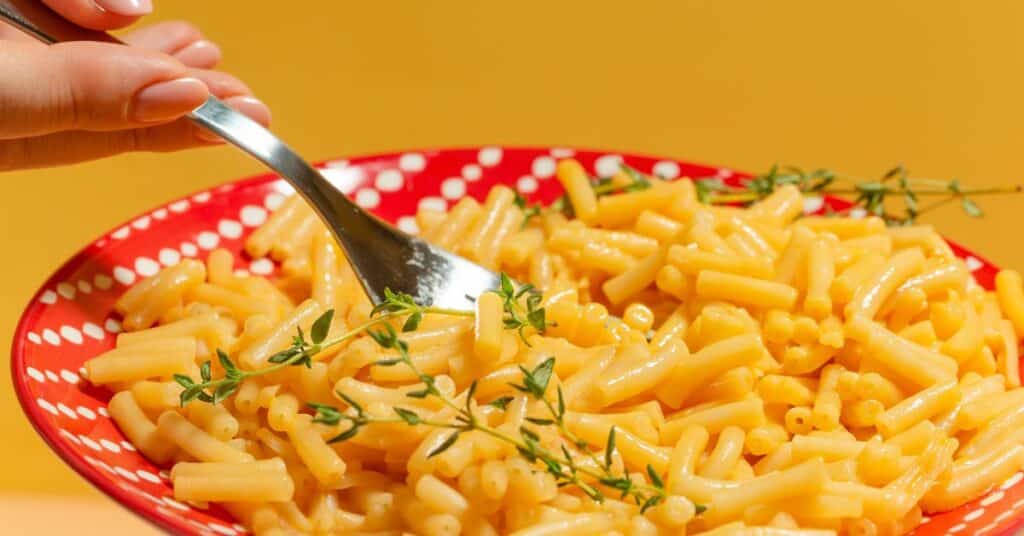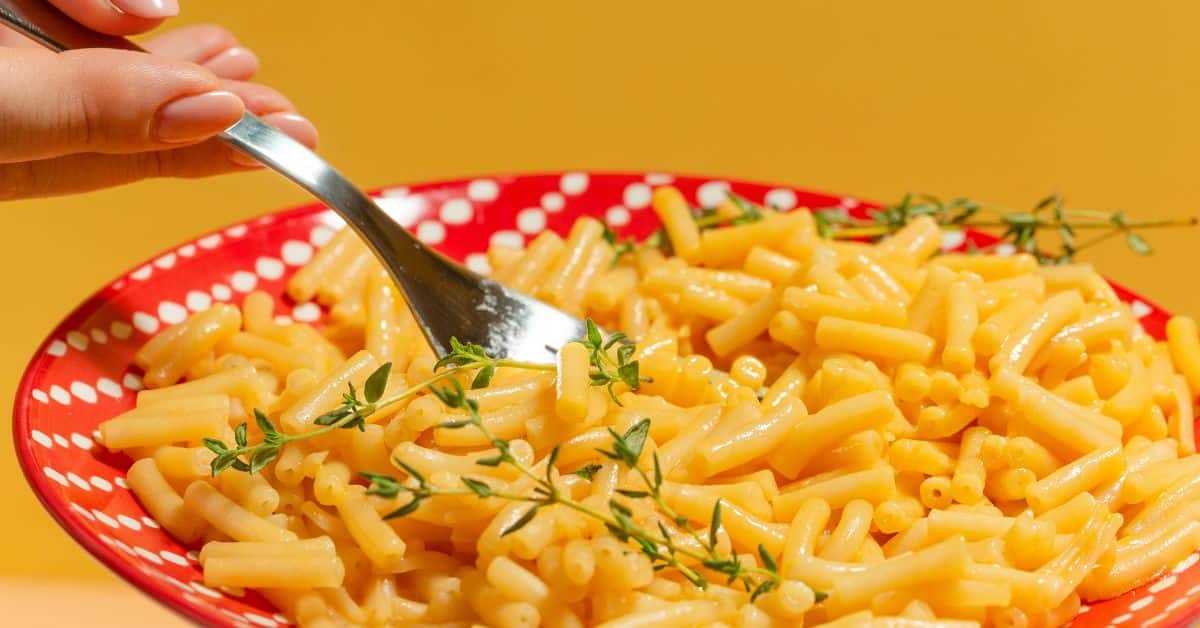
When you are too tired to make dinner, the best choice is to open up a box of Kraft Mac and Cheese, and you will get a plate of comforting and cheesy food in no time. Kraft Mac and Cheese calls for milk to be added, but you can still make delicious mac and cheese if you are short on milk or simply don’t want to use it.
So if you are wondering how to make Kraft Mac and Cheese with no milk…you are in the right place. Read ahead to find out!
What is Kraft Mac and Cheese?
Kraft Macaroni and Cheese is a processed cheese product made by Kraft Foods. It consists of cooked macaroni pasta and processed creamy cheese sauce stored in an iconic blue box.
It was first introduced in 1937 as a cheaper alternative to traditional macaroni and cheese. The processed cheese sauce was made with cheddar cheese, milk, butter, and salt. The dish became popular during World War II when rationing made it difficult to find fresh dairy products.
Today, Kraft Mac and Cheese is one of the most popular convenience foods in the United States. It is sold in both boxed and microwavable versions. The boxed version contains dry macaroni noodles and a packet of processed cheese sauce mix. The microwaveable version contains precooked noodles and a cup of processed cheese sauce.
Can you make Kraft Mac n Cheese without milk?
Kraft Mac and Cheese is a classic dish that most people love. It is made with a few ingredients, which include the mix from the box and milk. It gets its richness and creaminess from the milk. So, you would assume that milk is an essential ingredient when it comes to making Kraft Mac and Cheese. But what if you’re lactose intolerant or don’t have milk? Is it still possible to make this dish?
Fortunately, the answer is yes! You can make a box of Mac and Cheese without milk by substituting another liquid in its place. Just be sure to use the same amount of liquid as the recipe calls for milk.
With a few simple swaps, you can enjoy this classic comfort food without having to worry about dairy. So next time you’re in the mood for some Kraft Mac and Cheese, don’t let a lack of milk stop you from enjoying one of your favorite meals.
What to use instead of milk when making Kraft Mac and Cheese?
Kraft Mac and Cheese is a popular dish that can be made in many different ways using different ingredients. Some people like to add extra ingredients like leftover meat or spices to their mac and cheese, while others prefer to keep it simple. Regardless of how it is made, Kraft Mac and Cheese is a delicious and easy meal that can be enjoyed by everyone.
If you want to make Kraft Mac and Cheese without adding milk, don’t worry, we have a few ideas that will give you perfect results!
- Water: If you don’t have milk at hand, simply use pasta water in its place. You might not get the creamy richness, but it will surely work. You can always add more spices to build the flavors.
- Broth: You can also use vegetable, beef, or chicken broth to add flavors to the Kraft mac and cheese. Broths are a good substitute for milk.
- Non-dairy milk: If you don’t want to use dairy milk, go for a non-dairy milk substitute! Plant-based milks are the best milk substitutes. Try almond milk, soy milk, goat milk, cashew milk, coconut milk, or any other available.
- Cheese: Adding extra cheese like sharp cheddar, cream cheese, or even feta cheese is also a great substitute for milk, and it adds more creaminess and cheesiness.
- Meat and vegetables: Add in some extras like leftover meat or your favorite vegetables when making the dish. Or you can also go for more spices to get maximum flavor.
- Sour Cream or Greek Yogurt: Add a tablespoon or two of sour cream or plain Greek yogurt to create a creamy taste.
- Heavy Cream: Add some heavy cream to create the creamy texture that we love.
How to store Kraft Mac and Cheese
If you are storing Kraft Mac and Cheese in the fridge, then it should be placed in an airtight container. To freeze Kraft Mac and Cheese, place it in a freezer-safe container. It will keep for up to two months.
The oven is always the best option when it comes to reheating Kraft Mac and Cheese. Simply place the dish in a baking dish and reheat at a low temperature until warmed through.
Kraft Mac and Cheese recipe with no milk

- Preparation time: 10 minutes
- Cooking time: 20 minutes
- Total time: 30 minutes
- Servings: 2
Ingredients
- 1 box Kraft Mac and Cheese
- ¼ tsp. onion powder
- ¼ tsp. black pepper
- 1 tsp. garlic powder
- 1 ½ tablespoons of butter
- 3/4 cup vegetable broth
- 1 powdered cheese packet
Preparation
- Pour water into a large pot over medium-high heat. Bring water to a boil, then add noodles and cook according to the package instructions.
- Once done, drain noodles in a sieved colander and set aside.
- Add butter to the same pot over low heat. Once the butter melts, add 3/4 cup of vegetable broth.
- Then add the powdered cheese packet, onion powder, garlic powder, and pepper, and stir to cook until thoroughly combined.
- At this stage, add cooked noodles to the pot and stir gently until noodles are evenly coated.
- Once ready, transfer to the serving bowls and serve.

How to make Kraft Mac and Cheese with no milk
Ingredients
Method
- Pour water into a large pot over medium-high heat. Bring water to a boil, then add noodles and cook according to the package instructions.
- Once done, drain noodles in a sieved colander and set aside.
- Add butter to the same pot over low heat. Once butter melts, add vegetable broth.
- Then add powdered cheese packet, onion powder, garlic powder, and pepper, and stir to cook until thoroughly combined.
- At this stage, add cooked noodles to the pot and stir gently until noodles are evenly coated.
- Once ready, transfer to the serving bowls and serve.
Frequently Asked Questions
In this section, you’ll find answers to some common queries about Kraft Mac and Cheese, covering everything from nutritional content to creative cooking tips.
What are the nutritional details of boxed macaroni and cheese?
Each box of Kraft Mac & Cheese has varying nutritional content depending on the specific product line. Generally, a classic box contains about 250 calories per serving before milk or butter is added, along with a mix of carbohydrates, proteins, and fats.
Can you provide the cooking instructions for preparing boxed macaroni and cheese?
Sure! To prepare, boil six cups of water in a saucepan, stir in the macaroni, and cook for about 7-8 minutes. Drain the water, then add milk, butter, and the cheese sauce mix to the cooked macaroni. Stir thoroughly until creamy and well combined.
How much does a box of macaroni and cheese typically cost?
The price can vary based on location and retailer. However, a standard box of Kraft Macaroni & Cheese typically ranges from $1 to $3.
Where can I purchase boxed macaroni and cheese?
You can buy Kraft Macaroni & Cheese at most grocery stores, supermarkets, discount stores, and online retailers.
How many calories are in a serving of boxed macaroni and cheese?
A single serving of Kraft Macaroni & Cheese, which is about 1 cup prepared, typically contains around 400 calories when prepared with the recommended amounts of butter and milk.
What creative ways can I use to enhance the flavor of boxed macaroni and cheese?
To add a twist, try mixing in extras like shredded cheese, breadcrumbs, bacon bits, veggies, or hot sauce to elevate the flavor profile of your Kraft Mac & Cheese.
